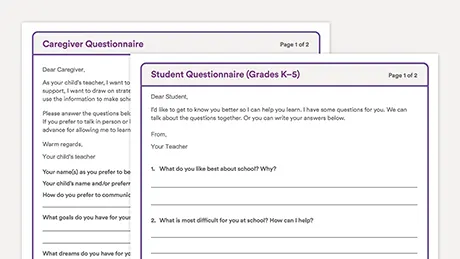Understanding empathy and compassionate curiosity

Empathy is a powerful tool that can help you connect with students. Whether it’s during everyday classroom life or in the most difficult moments, you can practice empathy and compassionate curiosity by asking questions, actively listening, and validating students’ feelings.
When you practice empathy, you convey to students: “I hear you. I want to understand how you feel. You are important.”
What empathy is and why it’s important
Empathy is a way of connecting with other people that shows you understand they are experiencing something meaningful, even though you may not understand exactly how it feels for them. It tells others that you’re feeling with them, and they’re not alone. Empathy isn’t the same thing as sympathy, which focuses on feeling sorry for someone.
Approaching and responding to students in empathetic ways can help you better understand their behavior and find strategies to support them. Because many students with learning and thinking differences often feel misunderstood, practicing empathy is an especially effective way to connect with them, make sure their voices are heard, and help them feel understood.
Learn more about what empathy is and how it can fuel student success.
7 ways to respond to students with empathy
Responding to students with empathy is important, but it’s not always easy. By focusing on a few techniques, you can improve how you show empathy in even the most stressful moments. The following tips can help you practice empathy:
Follow the “Platinum Rule” (treat others the way they want to be treated), not the “Golden Rule” (treat others how you want to be treated).
Don’t jump into “fix it” mode to try to solve a student’s problem.
Validate how students feel by telling them their feelings aren’t right or wrong.
Video: Compassionate curiosity and empathy
Approaching students with “compassionate curiosity” can help you become an investigator of why behaviors happen. Hear from Kyle Redford and Amanda Morin, both educators and parents of students with learning and thinking differences, to learn how you can become compassionately curious with your students.
Watch the full video to learn more about what it means to be compassionately curious.
Questionnaires for connecting with students and caregivers

There’s only so much you can learn about your students from prior work, testing, and records. Getting to know your students in a meaningful way comes from gathering information directly from primary sources — students and their caregivers. Questionnaires can help you gather insight about your students, so you can learn how to bolster their strengths and support them through their challenges.
Teacher-to-teacher: Use a daily warm-up to build empathy
Looking for a way to practice empathy and build meaningful relationships with students — in just a few minutes every day? Teacher Kate Garcia shares a valuable empathy self-assessment tool, the Toronto Empathy Questionnaire, and then details an activity from her classroom. She incorporates one personal question into her daily warm-up routine as a way to connect with students.
Through Your Child’s Eyes
It’s one thing to read about learning and thinking differences; it’s another to experience them as students do. The Through Your Child’s Eyes tool allows you to do just that. Watch the video about Jade and choose one or more simulations to experience. Could you relate in any way? Have you experienced a similar struggle, or have you worked with a student who shared that struggle?
Consider sharing this resource to build awareness in your school community:
Share the videos and simulations with other teachers in a meeting or email.
Talk with a small group of teachers about how the videos and simulations might help them empathize with students who have learning and thinking differences. How could they respond differently the next time they recognize a student’s struggle?
Email the tool to parents (of students both with and without learning and thinking differences).



